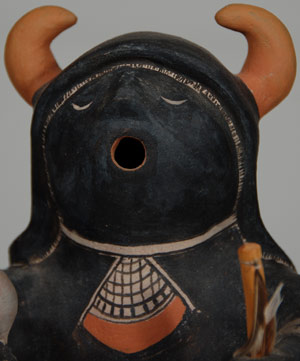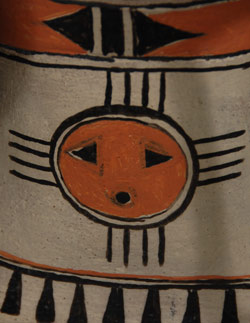Cochiti Pueblo Male Buffalo Dancer Figurine [SOLD]
+ Add to my watchlist Forward to Friend
- Category: Figurines
- Origin: Cochiti Pueblo, KO-TYIT
- Medium: clay, pigment
- Size: 13-7/8” tall + ¾” pedestal
- Item # 25600 SOLD

Animal dances at the pueblos are a plea for rain and for bountiful crops as well as an abundance of animals for food. Generally, buffalo, deer, antelope, and rams are portrayed together at a dance in the plaza. It is one of the most often seen dances in the fall and winter.
Here, Louis Naranjo has made an excellent likeness of a Buffalo Dancer. On his head he is wearing a buffalo skin with horns. The back of the head piece is decorated with a floral element and feathers. Around his body he is wearing a dance kilt. The kilt has a traditional Zia Pueblo Sun image; an image selected 100 years ago as the image for the New Mexico state flag. Tin cones are painted as fringe on the kilt and a belt ties around the waist.
The body of the dancer has been painted to resemble the darkness of the buffalo. In his right hand he carries a drumbeater and in his left a prayer stick. A shell necklace, moccasins, leggings and jewelry on both wrists complete the decoration. The sculpting of the figurine is excellent and the painting is exquisite.

Although the figurine will stand unassisted, it has been provided with a Plexiglas pedestal and wire support that provides more security. The stand adds another ¾-inch to the overall height of the figure. The figurine is signed Louis Naranjo Nov. 14, 1987 Cochiti, N.M. on the underside of the feet.
Condition: original condition.
Provenance: from the collection of Chuck and Jan Rosenak, renowned collectors and authors of Navajo Folk Art.
Recommended Reading: There is an excellent article on Louis and Virginia Naranjo in Indians of New Mexico, edited by Richard C. Sandoval and Ree Sheck. Published by New Mexico Magazine, Santa Fe, 1990. ISBN 0-937206-16-4. It may be available from the publisher.
- Category: Figurines
- Origin: Cochiti Pueblo, KO-TYIT
- Medium: clay, pigment
- Size: 13-7/8” tall + ¾” pedestal
- Item # 25600 SOLD



